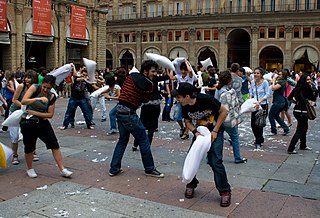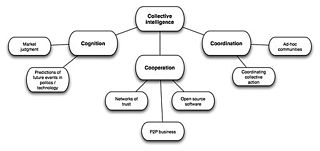Technological convergence is the tendency for technologies that were originally unrelated to become more closely integrated and even unified as they develop and advance. For example, watches, telephones, television, computers, and social media platforms began as separate and mostly unrelated technologies, but have converged in many ways into an interrelated telecommunication, media, and technology industry.

A flash mob is a group of people who assemble suddenly in a public place, perform for a brief time, then quickly disperse, often for the purposes of entertainment, satire, and artistic expression. Flash mobs may be organized via telecommunications, social media, or viral emails.

A smart mob is a group whose coordination and communication abilities have been empowered by digital communication technologies. Smart mobs are particularly known for their ability to mobilize quickly.
Alternative media are media sources that differ from established or dominant types of media in terms of their content, production, or distribution. Sometimes the term independent media is used as a synonym, indicating independence from large media corporations, but this term is also used to indicate media enjoying freedom of the press and independence from government control. Alternative media does not refer to a specific format and may be inclusive of print, audio, film/video, online/digital and street art, among others. Some examples include the counter-culture zines of the 1960s, ethnic and indigenous media such as the First People's television network in Canada, and more recently online open publishing journalism sites such as Indymedia.
net.art refers to a group of artists who have worked in the medium of Internet art since 1994. Some of the early adopters and main members of this movement include Vuk Ćosić, Jodi.org, Alexei Shulgin, Olia Lialina, Heath Bunting, Daniel García Andújar, and Rachel Baker. Although this group was formed as a parody of avant garde movements by writers such as Tilman Baumgärtel, Josephine Bosma, Hans Dieter Huber and Pit Schultz, their individual works have little in common.

Henry Jenkins III is an American media scholar and Provost Professor of Communication, Journalism, and Cinematic Arts, a joint professorship at the University of Southern California (USC) Annenberg School for Communication and Journalism and the USC School of Cinematic Arts. He also has a joint faculty appointment with the USC Rossier School of Education. Previously, Jenkins was the Peter de Florez Professor of Humanities as well as co-founder and co-director of the Comparative Media Studies program at the Massachusetts Institute of Technology (MIT). He has also served on the technical advisory board at ZeniMax Media, parent company of video game publisher Bethesda Softworks. In 2013, he was appointed to the board that selects the prestigious Peabody Award winners.
Transmedia storytelling is the technique of telling a single story or story experience across multiple platforms and formats using current digital technologies.
Bill Wasik is the editorial director of The New York Times Magazine, and self-proclaimed originator of the flash mob.

Collective intelligence (CI) is shared or group intelligence (GI) that emerges from the collaboration, collective efforts, and competition of many individuals and appears in consensus decision making. The term appears in sociobiology, political science and in context of mass peer review and crowdsourcing applications. It may involve consensus, social capital and formalisms such as voting systems, social media and other means of quantifying mass activity. Collective IQ is a measure of collective intelligence, although it is often used interchangeably with the term collective intelligence. Collective intelligence has also been attributed to bacteria and animals.

Culture Factory Polymer was a multidisciplinary centre for artistic creation and diffusion in Tallinn, Estonia. Located in Lilleküla, Kristiine District, on the fringes of the Tallinn city centre, this former toy factory became in 2003 one of the main strong points for alternative un-institutionalized culture in Tallinn.

Internet art is a form of new media art distributed via the Internet. This form of art circumvents the traditional dominance of the physical gallery and museum system. In many cases, the viewer is drawn into some kind of interaction with the work of art. Artists working in this manner are sometimes referred to as net artists.
Contemporary Indigenous Australian art is the modern art work produced by Indigenous Australians, that is, Aboriginal Australians and Torres Strait Islander people. It is generally regarded as beginning in 1971 with a painting movement that started at Papunya, northwest of Alice Springs, Northern Territory, involving Aboriginal artists such as Clifford Possum Tjapaltjarri and Kaapa Tjampitjinpa, and facilitated by white Australian teacher and art worker Geoffrey Bardon. The movement spawned widespread interest across rural and remote Aboriginal Australia in creating art, while contemporary Indigenous art of a different nature also emerged in urban centres; together they have become central to Australian art. Indigenous art centres have fostered the emergence of the contemporary art movement, and as of 2010 were estimated to represent over 5000 artists, mostly in Australia's north and west.
The Vera List Center for Art and Politics is an American nonprofit research organization and public forum for art, culture, and politics, established in 1992. Vera List was an American art collector and philanthropist.

Culture jamming is a form of protest used by many anti-consumerist social movements to disrupt or subvert media culture and its mainstream cultural institutions, including corporate advertising. It attempts to "expose the methods of domination" of mass society.
The Africa Centre, in Cape Town, South Africa, is structured as a not-for-profit organisation whose purpose is to provide a platform for Pan-African arts and cultural practice to function as a catalyst for social change. All the projects it conducts, facilitates or supports have some social intention. These projects are supported by a variety of Pan-African artists.

The Chicano Art Movement represents groundbreaking movements by Mexican-American artists to establish a unique artistic identity in the United States. Much of the art and the artists creating Chicano Art were heavily influenced by Chicano Movement which began in the 1960s.

An art game is a work of interactive new media digital software art as well as a member of the "art game" subgenre of the serious video game. The term "art game" was first used academically in 2002 and it has come to be understood as describing a video game designed to emphasize art or whose structure is intended to produce some kind of reaction in its audience. Art games are interactive and the result of artistic intent by the party offering the piece for consideration. They also typically go out of their way to have a unique, unconventional look, often standing out for aesthetic beauty or complexity in design. The concept has been extended by some art theorists to the realm of modified ("modded") gaming when modifications have been made to existing non-art games to produce graphic results intended to be viewed as an artistic display, as opposed to modifications intended to change game play scenarios or for storytelling. Modified games created for artistic purposes are sometimes referred to as "video game art".
Neo-Dada Organizers, often shortened to Neo-Dada (ネオ・ダダ), was a short-lived but influential Japanese Neo-Dadaist art collective formed by Masunobu Yoshimura in 1960. Composed of a small group of young, up-and-coming artists who met periodically at Yoshimura's "White House" atelier in Shinjuku, the Neo-Dada Organizers engaged in all manner of visual and performance artworks, but specialized in producing disturbing, impulsive spectacles, often involving physical destruction of objects, that the art critic Ichirō Hariu deemed "savagely meaningless," and that inspired another art critic, Yoshiaki Tōno, to coin the term "anti-art" (han-geijutsu). Examples included filling galleries with piles of garbage, smashing furniture to the beat of jazz music, and prancing the streets of Tokyo in various states of dress and undress. Using the human body as their medium of art, their violent performances reflected both their dissatisfaction with the restrictive environment of the Japanese art world at the time, as well as contemporary social developments, most notably the massive 1960 Anpo protests against the U.S.-Japan Security Treaty.
In media studies and marketing, spreadability is the wide distribution and circulation of information on media platforms.
Convergence culture is a theory which recognizes changing relationships and experiences with new media. Henry Jenkins is accepted by media academics to be the father of the term with his book Convergence Culture: where old and new media collide. It explores the flow of content distributed across various intersections of media, industries and audiences, presenting a back and forth power struggle over the distribution and control of content.









